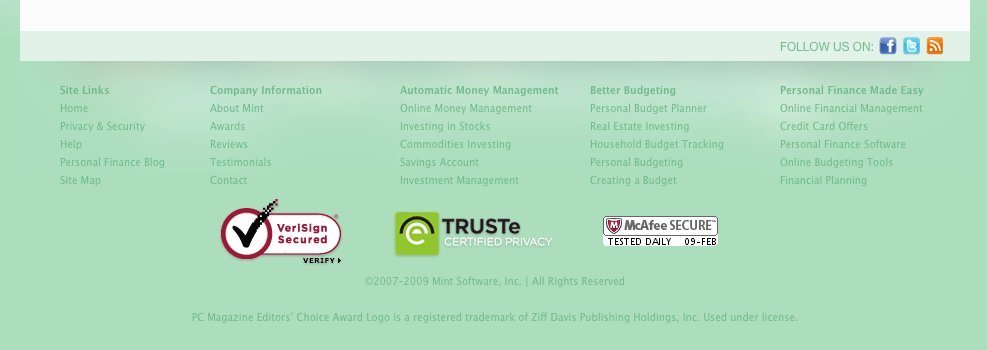Internet scams, stories about stolen credit card information, and the conspiracy theorist inside keep us from trusting websites, who wish to let us create an account or sell us something. Will data I enter into here be misused? Will I receive spam when giving my email away? Do I really want to share this private information with a stranger I do not know?
I love the mint.com – a service that scans your credit card usage in order to analyze your spending and help you make and keep budgets. I however, I keep refraining from signing up. Why? I simply do not feel like trusting them with such private information as my credit card details. My fear is probably unrooted, but still I’m scared.
The lack of trust in a website creates friction. The lack of trust creates hurdles the user needs to pass. In order to lower friction and the hurdles to pass, users need to be provided with a reason to trust you with the information they supply. The time and effort required to complete a form should be appropriate for the task at hand. A constant battle between the reward for completing an action and the effort it takes to complete it, is at play at all times.
You can communicate trustworthiness in several ways
- Design quality. A professional appearance gives the user a good gut feeling. If the site is easy to use and it looks good, it shows the user that these people know what they’re doing. Good design quality implies respect for the user and promise of a good service, where the opposite communicates disregard for the user.
- Let your users know what is going to happen. Both in regards to the process, but also the data they are providing you with. Let your users know what is going to happen with the data they provide. Can they expect a call if they provide their phone number? If you request a user’s email, he or she will wonder how much spam is going to be sent. So let them know that it’s just for informing you about shipment, possible delays, and invoicesc – nothing else. Tell the users why you need the information if it is personal.
- Use trust indicators. Use the badges of secure payment gateways that everybody knows. Brands like PayPal or VeriSign convey a sense of security and put most doubts about data theft and security to rest. Credit card icons also provide a great a sense of comfort. A credit card form without credit card icons feels wrong. I wouldn’t use it! Other trust indicators are the brand names you sell, money back guarantees, industry standards or ratings.
- Social proof. Social proof is a trust indicator that needs its own bullet. Show that previous (perhaps prominent) customers are happy with the service you provide and have them give testimonials about how you helped them. If your potential customers are in doubt whether they should trust you or not, the behavior of all the other people who weren’t in doubt might be the tipping point. The effect of Social Proof relies on the assumption that surrounding people possess more knowledge about the situation, why they will deem the behavior of others as appropriate or better informed.
BuySellAds.com
Buysellads displays a series of badges and icons that each communicate security and trust.

Buysellads displays a series of badges and icons that each communicate security and trust.
Mint.com
Mint.com has a high focus on conveying a sense of trust in that the service is secure showing badges from VerySign, TrustE, and McAfee.

Mint.com has a high focus on conveying a sense of trust in that the service is secure showing badges from VerySign, TrustE, and McAfee.
Asos.com
The icons at the bottom of the asos.com footer help communicate a sense of security and help the potential customer put trust in asos.com.

The icons at the bottom of the asos.com footer help communicate a sense of security and help the potential customer put trust in asos.com.
5 comments
Curtis Lassam on Feb 11, 2010
These strategies are all well and good, but in order to increase user trust in my websites, I always go to the big guns: A picture of Sam The American Eagle from the Muppets.
Most people, upon seeing the picture for the first time, will immediately turn over all of their details – credit card numbers, social insurance information, bank account transfers – for safekeeping. That is how secure they feel, having seen the picture of Sam the American Eagle.
Anders Toxboe on Feb 11, 2010
@Curtis Lassam: Ha ha ha! Gotta try that! :-)
Scoremore on Nov 17, 2010
thanks for sharing all of this information about mint.com,i now love it.thank you for sharing the trustworthiness in several ways,this is very helpful.we really need to do something to avoid internet scams..
creditcardrays on Nov 26, 2010
This is very niche and excellent content love to see more post like this..keep posting. Thanks for information ..bravo…
Ty the Web Guy on Dec 06, 2010
Glad to see design quality is the first item listed for building trust. That’s important, since the visual design is the first impression of the site, and with Google’s recent addition of previewing the destination page design may become more essential to getting clicks.
But anyone can download a free template for WordPress that looks professional. It goes deeper than just the surface. The content style needs to match the visual design…how headlines are written and text is composed. Site owners need to spend some serious time reading through content and navigating the site like their visitors will. Too many people seem to throw together a quick site without much thought beyond the prettiness of the page design.
Comments have been closed